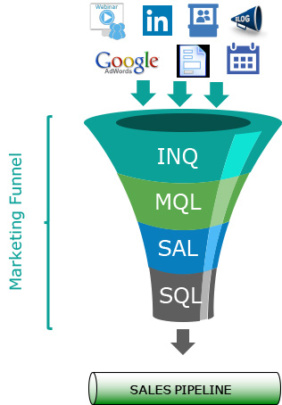On a recent lead generation training course, I was very surprised to find a large majority of salespeople among the participants. It turned out that these sales reps were attending because their marketing wasn’t delivering leads that made sense from a sales perspective. Some of them had KPIs for cold calling, and results were reportedly getting worse and worse.
This situation again illustrates that the majority of businesses in Europe haven’t yet realised we’ve arrived in the ‘age of the customer’. Not that the customer has changed, but thanks to the internet, social media and new mobile possibilities, buyers have changed the way they interact with us. Organisations that want to secure or grow their business shouldn’t wait any longer to start looking at ways of meeting the empowered customer’s needs.
A well-oiled sales and marketing machine is essential

Buyers today can find loads of information about your products, and your competitors’, in just a few clicks. If you want to do business with leads who are looking for a solution like yours, it’s the marketing department’s job to provide the right information in the right form, at the right time in your lead’s buying cycle.
Cost efficiency and volume are key: marketing generates leads in a one-to-many digital approach. Only leads that meet specific marketing criteria (MQL) are being handed over to sales, who then take over from there. Sales qualifies both the contact and the buyer readiness (SQL), and leads rejected by sales are recycled by marketing into campaigns that can be made very specific thanks to the new insights gained by sales.
One marketing activity that is often forgotten is demand generation: besides capturing ready-to-buy leads, marketing can also create demand through inbound marketing. Leads from these campaigns can be nurtured to hopefully become sales-ready one day. Without demand generation, sales will keep on complaining about the quantity and quality of leads provided by marketing.
So has your machine been oiled to meet new customer demands?
How to get the machine running
If your machine’s a bit sluggish, it’s probably time to stop the ongoing battle between sales and marketing. Take a new look at activities and responsibilities, and create a value chain that helps your customers buy from you.
Here are a few tips to get sales and marketing collaboration on track.
- Share common goals
Across departments, increase awareness that we’re all trying hard to achieve the same company targets. Collaboration is key! - Share a common vocabulary
In the age of the customer, replace your sales process with a buying process, and make sure both sales and marketing are speaking the same language. Introduce a clear demand-generation process with milestones based on commonly agreed definitions to make it work - Co-development and best practice
Work together as one team. Both sales and marketing can add lots of value, insights and messaging to improve traction, conversion and ROI on marketing activities. Sales meetings are an ideal platform to keep marketing up-to-date with what’s happening in the market; marketing can take the stage to inform sales about ongoing results and planned activities in line with the sales organisation’s needs, again reinforcing the importance of common goals - Marketing: messaging should allows the building of customised content
Research has shown that that up to 90% of content created by marketing goes unused by sales. Implement a content strategy that enables the building, sharing, measurement and improvement of messaging quality. Messaging should allow the building of content that is customised for different roles, their individual buyer readiness, and context - Marketing: ‘why change’ content
The majority of content aims to convince us why we should choose company X or product Y. But research shows that 60% of opportunities are neither won nor lost; they simply disappear without a sale. The content that explains why customers should change is therefore crucial for creating demand and increasing conversion
Want to find out more and see the whole picture? Watch the webinar ‘How to Align Sales and Marketing’ with guest speaker Pascal Persyn, CEO at Perpetos, and moderator Deva Rangarajan, Associate Professor at Vlerick.

[ON-DEMAND WEBINAR]
How to Move Stalled Sales Opportunities?
Procrastination comes in different guises. 3 steps to avoid procrastination
Dealing with Late Cycle Concerns



 Pascal Persyn
Pascal Persyn

